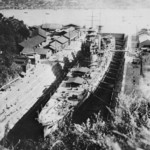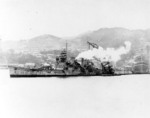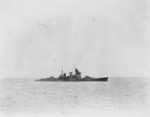Haguro
| Country | Japan |
| Ship Class | Myoko-class Heavy Cruiser |
| Builder | Mitsubishi Nagasaki Shipyard |
| Laid Down | 16 Mar 1925 |
| Launched | 24 Mar 1928 |
| Commissioned | 25 Apr 1929 |
| Sunk | 16 May 1945 |
| Displacement | 10,980 tons standard; 13,300 tons full |
| Length | 662 feet |
| Beam | 68 feet |
| Draft | 21 feet |
| Machinery | 4-shaft geared turbines, 12 boilers |
| Power Output | 130,000 shaft horsepower |
| Speed | 36 knots |
| Range | 8,000nm at 14 knots |
| Crew | 1,200 |
| Armament | 10x8in, 6x4.7in (1934 and before) or 8x5in (1935 and after) |
| Armor | 4in belt, 1.3in main deck, 1in turrets, 3in barbettes |
| Aircraft | 2 |
Contributor: C. Peter Chen
ww2dbaseHaguro, was the fourth and last of the Myoko-class heavy cruisers. She served with the Fourth Sentai (Squadron) between 1929 and 1933 and later the Fifth Sentai. During the precursors to WW2, she carried troops to China in 1932. In late 1935, she was modified with torpedoes and modern anti-aircraft weaponry.
ww2dbaseAfter WW2 began in Asia, Haguro carried troops to China in 1937 and then remained in the region to provide her guns for blockade and naval gunfire support missions. At the start of the Pacific War, she participated in the landings at the Philippines and also participated in the Battle of the Java Sea where she played a part in the sinking of HMS Exeter and HMS Encounter. She also participated in actions off Borneo on 1 Mar 1942, Battle of Coral Sea on 7 May 1942, Battle of Midway on 4 Jun 1942, Battle of the Eastern Solomons on 24 Aug 1942, Battle of Empress Augusta Bay on 2 Nov 1943, Battle of the Philippine Sea on 19 Jun 1944, and then Battle of Sibuyan Sea and Battle off Samar in the Leyte Campaign in Oct 1944.
ww2dbaseIn 1945, Haguro was stationed at Singapore escorting logistics missions under Vice Admiral Shigeru Fukudome. In May 1945, she was the target of the British Operation Dukedom. Five British destroyers of the 26th Destroyer Flotilla intercepted Haguro and destroyer Kamikaze in the Bay of Bengal off the northern tip of Sumatra. The two Japanese ships were headed for the Andaman and Nicobar Islands with food and other supplies. Despite Haguro being overloaded with supplies which restricted half of her main guns from being operational, she scored three hits on a British destroyer, though only causing non-critical damage. She eventually was damage by gunfire and then critically wounded by three Mark IX torpedoes. She suffered a 30-degree list to port, which quickly turned for the worse within the hour. At 0232 on 16 May 1945, she sank in the Malacca Strait off Penang with only 320 survivors. The captain of Haguro, Vice Admiral Hashimoto, and Rear Admiral Shiguira were among the 900 men who were lost.
ww2dbaseSources: Interrogation of Japanese Officials, Naval Historical Center, Wikipedia.
Last Major Revision: Feb 2007
Heavy Cruiser Haguro Interactive Map
Photographs
 |  |  |  |
Haguro Operational Timeline
| 25 Apr 1929 | Haguro was commissioned into service. |
| 27 Feb 1942 | American seaplane tender USS Langley with 32 P-40 fighters aboard, en route to Java, was sunk by Japanese Navy land-based aircraft. On the same day, at the Battle of the Java Sea, Japanese cruisers Haguro and Nachi sank Dutch cruisers HNLMS Java and De Ruyter along with destroyer HNLMS Kortenaer and two other Dutch destroyers with Type 93 torpedoes without any Japanese losses. |
| 8 May 1942 | Japanese and US carrier fleets at Coral Sea discovered each other in the morning, each closing in to attack. Japanese carrier Shokaku was damaged by 3 bombs at 1057 hours (223 casualties), while American carrier USS Lexington was hit by two bombs at 1120 hours (191 killed at 1120 hours; gasoline explosion at 1247 hours killed another 25; scuttled by USS Phelps at 1915 hours) and American carrier USS Yorktown was hit by a bomb (66 casualties). Meanwhile at Port Moresby, an Australian cruiser force successfully defended itself against land-based aircraft attack as it blocked the Japanese invasion fleet for Port Moresby, New Guinea. As both sides withdrew due to damage and losses, the Japanese scored a tactical victory, but lost strategic momentum as the Port Moresby invasion must now be delayed. |
| 8 May 1943 | Yamato, Chuyo, Unyo, Myoko, Haguro, Yugure, Naganami, Samidare, and Ushio departed Truk, Caroline Islands. |
| 13 May 1943 | Yamato, Chuyo, Unyo, Myoko, Haguro, Yugure, Naganami, Samidare, and Ushio arrived at Yokosuka, Japan. Later on the same day, Yamato departed for Kure, Japan. |
| 18 Sep 1943 | Yamato, Nagato, Shokaku, Zuikaku, Takao, Atago, Myoko, Haguro, and a destroyer screen sortied from Truk, Caroline Islands to Brown Island (Eniwetok), Marshall Islands with Combined Fleet under Vice Admiral Jisaburo Ozawa's tactical command in response to the US Task Force 15 carrier raids on Tarawa and Makin. |
| 13 Jun 1944 | Shokaku, Zuikaku, Taiho, Ryuho, Haguro, Myoko, Yahagi, Asagumo, Isokaze, Urakaze, Hatsuzuki, Wakazuki, Akizuki, and Shimotsuki departed Tawi-Tawi, Philippines toward Saipan, Mariana Islands in anticipation of an American attack. At 1830 hours, Japanese Combined Fleet leadership ordered the preparation of A-Go Operation. |
| 14 Jun 1944 | Shokaku, Zuikaku, Taiho, Ryuho, Haguro, Myoko, Yahagi, Asagumo, Isokaze, Urakaze, Hatsuzuki, Wakazuki, Akizuki, and Shimotsuki arrived at Guimaras island, Philippines in the afteroon. |
| 15 Jun 1944 | The Japanese Combined Fleet activated A-Go Operation at 0717 hours as the Americans commenced their invasion of Saipan, Mariana Islands. At 0800 hours, Shokaku, Zuikaku, Taiho, Ryuho, Haguro, Myoko, Yahagi, Asagumo, Isokaze, Urakaze, Hatsuzuki, Wakazuki, Akizuki, and Shimotsuki departed Guimaras Island, Philippines toward Saipan, passing through San Bernardino Strait at 1730 hours. |
| 16 Jun 1944 | Shokaku, Zuikaku, Taiho, Ryuho, Haguro, Myoko, Yahagi, Asagumo, Isokaze, Urakaze, Hatsuzuki, Wakazuki, Akizuki, and Shimotsuki commenced refueling operations in Philippine waters. |
| 17 Jun 1944 | Shokaku, Zuikaku, Taiho, Ryuho, Haguro, Myoko, Yahagi, Asagumo, Isokaze, Urakaze, Hatsuzuki, Wakazuki, Akizuki, and Shimotsuki departed Philippine waters ad sailed toward Saipan, Mariana Islands at 1530 hours. At 2015 hours, USS Cavalla made radar contact with the Japanese carrier fleet in the Philippine Sea; Commander Herman Kossler decided to sail away in order to surface later, at 2245 hours, to send the contact report to his superiors. Receiving this news, US Navy leadership ordered search planes to be sent to look for this carrier fleet, thus setting up for the subsequent Battle of the Philippine Sea. |
| 19 Jun 1944 | At dawn, flagship Taiho, Shokaku, and Zuikaku launched launched combat air patrol fighters. At 0756 hours, the first major strike force was launched (48 fighters, 53 bombers, and 27 torpedo bombers; led by Lieutenant Commander Akira Tarui). At 0810 hours, USS Albacore hit Taiho with a torpedo in the starboard bow, but Taiho's damage control team allowed the carrier to remain in formation; destroyer Hatsuzuki was left behind to hunt for USS Albacore. At 1020 hours, Zuikaku launched a second strike force (4 fighters and 4 bombers) to join the fourth big raid on on US Navy Task Force 58. Meanwhile, Taiho suspended flight operations due to gas vapor issues and Shokaku was busy with combat air patrol duties through well past 1100 hours. At 1100 hours, Shokaku began recovering 10 fighters; while the recovery process continued, at 1122, Shokaku was hit by three torpedoes from USS Cavalla on the starboard side; two forward near the switchboard and generator room, one aft of amidships. Large fuel fires were ignited in the hangar and No. 1 boiler room went offline. Shokaku remained underway, but began to list to starboard. Counterflooding over-compensated, giving her a port list. Meanwhile flooding and heat of the fires forced shutting down of the boiler rooms. She continued to settle forward. Though damage control initially hoped to save her, the flooding forward and the fires intensify in the following hours. By 1210 hours Shokaku had come to a halt when fires detonate an aerial bomb on the hangar, setting off volatile gases from a cracked forward tank. Large induced explosions wrecked the carrier, and hope began to fade. The list to port and bow trim both increased. Carriers Zuikaku and Taiho were ordered to leave damaged Shokaku behind, while cruiser Yahagi and destroyer Urakaze remained with Shokaku. At 1350 hours, Shokaku strike planes returned, but were ordered away, redirected to Zuikaku and Taiho. By the time Taiho's aircraft returned, the gas vapor leak problem became extremely worrisome, and some of Taiho's aircraft were redirected to Zuikaku. At this time Captain Hiroshi Matsubara of Shokaku had ordered the carrrier abandoned and the crew mustered on the flight deck for flag lowering. However, before the evacuation can proceed far, the bow dipped under and water pours into No. 1 elevator well, causing the carrier to corkscew to port and up-end. Shokaku went down by the bow at 1401 hours, stern raised high. Between 1408 and 1411, four underwater explosions were registered. 58 officers, 830 petty officers and men, 376 members of Air Group 601, and 8 civilians were killed, totalling 1,272 deaths in the sinking of Shokaku. Light cruiser Yahagi and destroyers Urakaze and Hatsuzuki rescued Captain Hiroshi Matsubara among 570 other survivors. At 1432, another disaster struck as the gas vapor aboard Taiho detonated; the explosion engulfed the flagship. Zuikaku was ordered to proceed while Vice Admiral Jisaburo Ozawa to transferred his flag to cruiser Haguro. At the end of the day, the Japanese Navy lost 244 of the 374 aircraft that it had launched during this battle. The US Navy had only lost 20 aircraft. |
| 20 Jun 1944 | At 1130 hours, the Japanese Mobile Fleet, withdrawing west from the losses sustained on the previous day during the Battle of the Philippine Sea, paused to refuel from tankers while Vice Admiral Jisaburo Ozawa transferred his flag aboard Zuikaku. At 1500 hours, cruiser Atago reported seeing an American scout plane, and Ozawa ordered the refueling to be stopped and the fleet was to sail to the northwest at the speed of 24 knots. At 1725 hours, a large incoming American strike was detected. The Japanese mustered 17 fighters for defense, while the Haguro, Myoko, Yahagi, and seven destroyers formed a tight circle around Zuikaku. 95 American fighters, 54 torpedo bombers (most of which were armed with bombs rather than torpedoes), and 77 dive bombers from USS Hornet, USS Yorktown, and USS Belleau Wood arrived at 1730 hours, hitting Zuikaku once with a bomb, causing some damage. |
| 15 May 1945 | British destroyer forces sank the Japanese cruiser Haguro in the Malacca Strait off the Malay Peninsula. |
| 16 May 1945 | Aircraft from escort carrier HMS Emperor attacked Japanese cruiser Haguro at the entrance of the Malacca Strait. |
Please consider supporting us on Patreon. Even $1 per month will go a long way! Thank you. Please help us spread the word: Stay updated with WW2DB: |
Visitor Submitted Comments
All visitor submitted comments are opinions of those making the submissions and do not reflect views of WW2DB.

» Dutch East Indies Campaign, Java
» Battle of Coral Sea
» Battle of Midway and the Aleutian Islands
» Guadalcanal Campaign
» Solomon Islands Campaign
» Mariana Islands Campaign
» Philippines Campaign, Phase 1, the Leyte Campaign
Partner Sites Content:
» Haguro Tabular Record of Movement
- » 1,178 biographies
- » 337 events
- » 45,089 timeline entries
- » 1,245 ships
- » 350 aircraft models
- » 207 vehicle models
- » 376 weapon models
- » 123 historical documents
- » 261 facilities
- » 470 book reviews
- » 28,490 photos
- » 365 maps
Winston Churchill, on the RAF
Please consider supporting us on Patreon. Even $1 a month will go a long way. Thank you!
Or, please support us by purchasing some WW2DB merchandise at TeeSpring, Thank you!
6 Sep 2007 07:03:26 PM
I am very appreciated that your website provided us many photos that only we can see on book. Thanks again I live in Taiwam Taipei